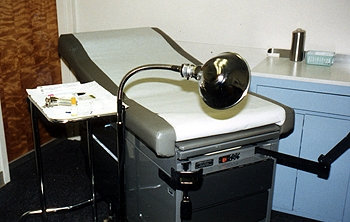































|
 November/December, 1998 Volume XIII Number 3
November/December, 1998 Volume XIII Number 3

The myth of safe abortions . . .

punctured by abortionists
by Mike Richmond
If one out of every 50 full-term births resulted in a punctured uterus, `pro-choicers' would have a `field day ` denouncing the dangers of motherhood. But since it is induced abortion (vacuum aspiration) that has the 1 in 50 risk of a punctured uterus, little is heard from the `pro-choicers'. From whence comes the 1 in 50 risk estimate? Abortionists Drs. Steven Kaali, George Bartfai, and Ivan Szigetvari in an August 1989 article published in the American Journal of Obstetrics and Gynecology. (1) But since other studies have reported lower estimates for uterine perforation rates, why highlight the 'Kaali' report? In the 'Kaali' study the doctors could actually see (via "direct laparoscopic visualization") the punctures. In their words:
"Two perforations (2.8/1000 procedures) were reported before laparoscopy. Twelve (15.6/1000 [sic] procedures) unsuspected perforations were discovered during direct laparscopic visualization. This represents a 19.8/1000 procedures rate of perforation (14 cases)..."
"Our data suggest that the true incidence of uterine perforation is significantly underestimated..."
How can a 'vacuum' procedure possibly lead to a punctured uterus? Dr. J.C. Willke informs us, "He then inserts a hollow tube which has a knife-like edge on the tip, into the uterus." (2) The plastic tube (with knife-life tip) serves TWO functions: a.) a vacuum channel and b.) a uterus scraper.
Women under general anesthesia are much less likely to feel excess force being applied and thus, less likely to warn the abortionist.
In the 1970's induced abortion was BESSIE (Blind Elective Surgery, Sharp Instruments Employed). In the 1980's abortion was still BESSIE and remains so today. The "World's Smartest Man," talk show host Dr. Bill Wattenburg (KGOAM810@aol.com), thinks BESSIE type procedures are just fine. But we have to ask, "Would he willing undergo a Blind Elective Surgery himself?"
He hasn't said.
Uterine [womb] perforations
In the 1970s one of the leading abortionists was Dr. Bernard N. Nathanson (an atheist at that time). In a medical journal article Dr. Nathanson tells about the possible side-effect of a perforated uterus (American Journal of Obstetrics and Gynecology, 1972, pp. 1054-1059).
What is the frequency of the womb being accidentally perforated? That is hard to say, since different researchers report numbers 'all over the map': Three per 1000 (according to Tietze and Lewit), and .4 per 1000 (according to Beric and Kupresanin), 9 per 1000 (according to Olsen, Nielsen, and Ostergaard), and 15 per 1000 (according to Courtney).
Nathanson writes,
"However, because uterine perforation is a surgical accident which occurs veiled from the observer's eye and because abortion is a one-man procedure, it is probably wise to assume that perforations reported in the various series are those which are most obvious and that many remain unreported either by design or through ignorance. Finally, in a unit in which the continued employment of the physician rests to some extent on his maintaining a low complication rate, it is perhaps cynical though reasonable to assume that many accidents, e.g., perforation with a dilator or sound, go unreported, ...... En fin, the crude figures of uterine perforation are at best of questionable value...... Regrettably, abortion is essentially a blind procedure by one pair of hands only, and it is impossible to teach it and supervise it as thoroughly as one can any type of open operation."
 Some time, in the 1980s Dr. Nathanson was convinced by the medical evidence that the unborn was a living human. He was still an atheist when he converted to this view. Some time in the 1990s Dr. Nathanson became a Roman Catholic.
Some time, in the 1980s Dr. Nathanson was convinced by the medical evidence that the unborn was a living human. He was still an atheist when he converted to this view. Some time in the 1990s Dr. Nathanson became a Roman Catholic.
Abortions aren't just dangerous, they are painful
A September of 1997 headline announced, "Planned Parenthood Doctor asserts that abortion is painful."
"We were surprised to note that the majority of women reported moderate or more discomfort during the procedure [induced abortion]; we had not expected as many women to report severe pain." (The Journal of Reproductive Medicine, Pain During Early Abortion, Dr. Lynn Borgatta and David Nickinovich (Ph.D.), 1997, vol. 42, pp. 287-293).
Co-author of the research, Dr. Lynn Borgatta is in the Medical Division of Planned Parenthood Federation of America (New York City).
In the study women were given six possible pain ratings from which to choose: none = 0, hardly any = 1, a little = 2, medium = 3, quite a bit = 4, severe = 5. Results (taken from table II):
ProcedureAll WomenNulliparous (childless)
Pain Score(1,055)(558)
016( 1.5%)10( 1.8%)
160( 5.7%)27( 4.8%)
2150(14.2%)62(11.1%)
3214(20.3%)116(20.8%)
4334(31.7%)191(34.2%)
5279(26.4%)152(27.2%)
What per cent of all women experienced 'quite a bit' or 'severe' pain during induced abortion? A total of 58.1% among women with no full term births (i.e. nulliparous) reported significant pain. Among all women this figure is 61.4%.
So, will consent forms be updated to warn women of pain from this 'safe and therapeutic' procedure?
Not likely. Ironically, there is the statement that "The views in this article [by Borgatta and Nikinovich] do not necessarily represent the views of Planned Parenthood Federation of America, Inc."
If a top medical doctor in Planned Parenthood is "surprised" at the pain experienced by women who underwent induced abortion, how can new patients be anything other than surprised by pain, if they are not warned?
Abortions aren't just harmful or painful, they are deadly
In the August 26, 1998 issue of JAMA, Dr. George Lundberg, editor of the Journal of the American Medical Association wrote,
"This editor considers abortion to be a religious issue-a decision to be reached by the pregnant woman, after consultation with the father (if possible), members of her family, perhaps a religious adviser, and the woman's physician..."(1)
Induced abortion has been legal in the 50 states in the USA for over 25 years. Young women who underwent this treatment in the 1970's are now mostly 'middle-aged' (ages 35-55).
Where is the published evidence that 'all-cause' mortality for women between the ages of 35 and 55 with at least one induced abortion is no higher that for women with no induced abortions in the same age range?
This question is of particular concern to black US women.
Why?
"In addition, abortion rates for black women (43 and 40 abortions per 1,000 women in 1993 and 1994, respectively) were approximately three times the rates for white women (15 and 13 abortions per 1,000 white women in 1993 and 1994, respectively)." (Special Focus: Surveillance for Reproductive Health, MMWR [CDC], 8 August 1997, Vol. 46, No. SS-4, pp. 36-98)
In the editorial Lundberg provided no proof that abortion doctors fulfill the legal requirement to protect a woman's health.
On February 20, 1998 the American Cancer Society (Dr. Clark Heath, Head of Epidemiology and Surveillance Research for ACS) conceded that a medically delayed first birth increases breast cancer risk, one of the leading killers of women in America.
 Has Dr. Lundberg ever read an induced abortion consent form? Where on any abortion clinic consent form can the words 'breast cancer risk' be found? Surely, he is not claiming that breast cancer is a religious rite too.
Has Dr. Lundberg ever read an induced abortion consent form? Where on any abortion clinic consent form can the words 'breast cancer risk' be found? Surely, he is not claiming that breast cancer is a religious rite too.
According to the Journal of the National Cancer Institute (1993), "Scientists agree that a full-term pregnancy at a young age protects against breast cancer."(2)
These concerns don't even address other causes of mortality among women who undergo abortion. However, pain, punctures to the uterus, and breast cancer provide enough reasons for Dr. Lundberg and others to warn women about the risks abortion poses to them, much less to their children.
References:
(1) The frequency and management of uterine perforations during first-trimester abortions, American J Obstetrics & Gynecology, Steven Kaali, et al., 1989;161:406-8
(2) Abortion: Questions & Answers (Dr. J.C. Willke, 1985)
OTHER
FEATURE
ARTICLES
Hugh Finn
An Emty Cradle, A Full Heart
36 points in regards to the Pittsburg Nightmare Case
Moral madness, moral insanity
The myth of safe abortions

|
|




